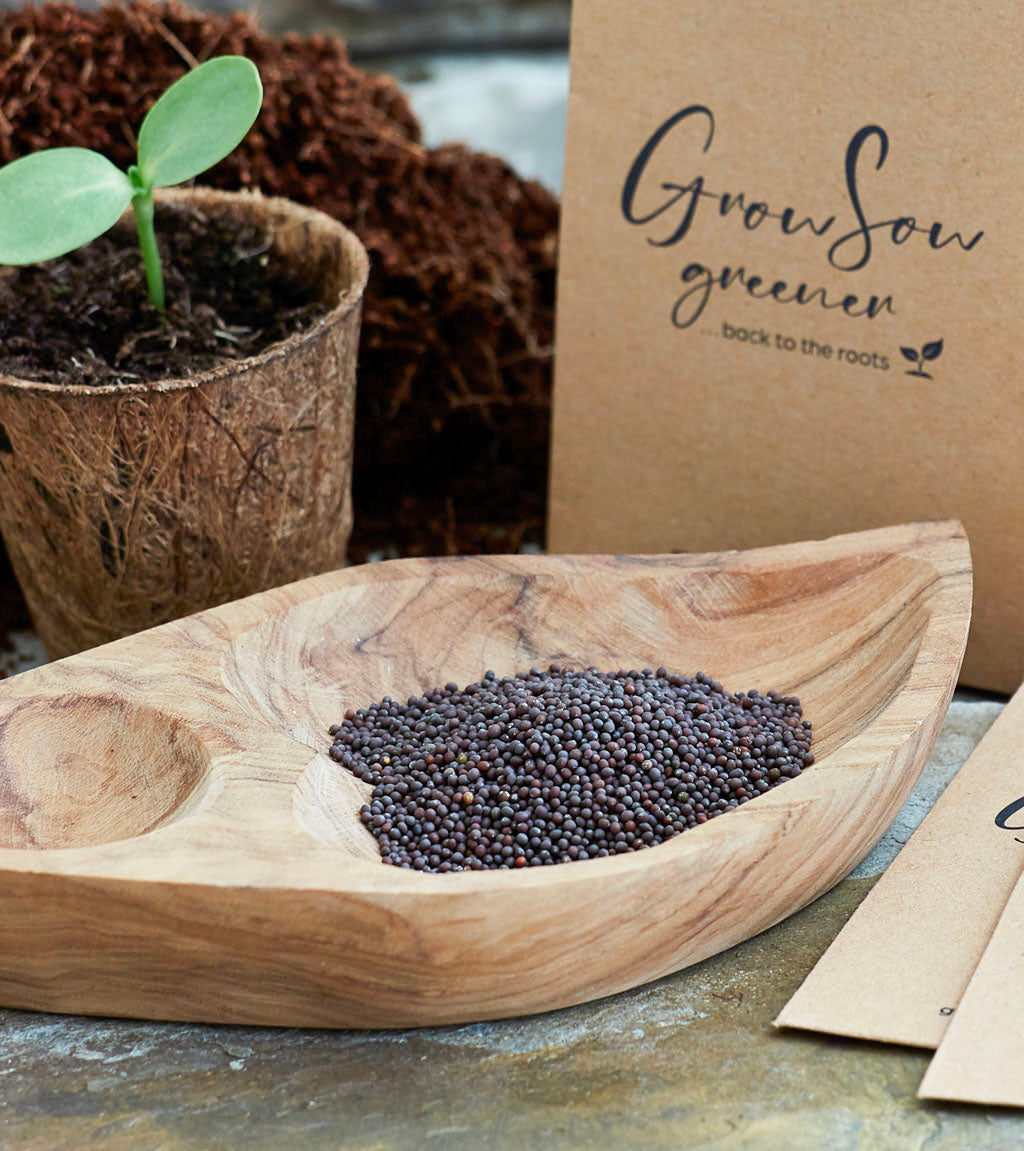Grow Sow Greener
Mustard Seeds - Green Frills
Mustard Seeds - Green Frills
Couldn't load pickup availability
An easy addition to your homegrown salads, Green Frills Mustard leaves pack plenty of flavour and nutritional benefits thanks to their antioxidant, anti-inflammatory and detoxifying properties. Also known as Golden Frill, these crunchy greens have a robust mustard flavour and delicate leaves which can be harvested year-round. Our Green Frills Mustard Seeds are GMO-free and hand-picked for quality right here in the UK.
Mustard is a stunning and delicious crop for the shoulder seasons. Green Frills Mustard has attractive and delicate, finely serrated leaves, adding a peppery warmth to your salads and sandwiches. It is simple to grow and largely pest-free. A punchy low fuss plant which stands out in any dish.
- Pack size: 150 seeds
- Time to germination: 5 - 12 days
- When to sow indoors: February - October
- When to sow outside: April - October
- When to plant out: March - October
- Spacing: 20-30cm
- Soil preference: Broad tolerance
- Light preference: Full sun, part shade
- When to harvest: Year-round
How to grow Green Frills Mustard from seed
Mustard is extremely versatile. Scatter seeds in a tray for spicy microgreens, grow a pot on the kitchen windowsill for baby leaf salad greens, sow direct where they are to grow, or, as we prefer, sow in biodegradable thin wall coco pots which will allow the roots to grow through for quick establishment in the garden bed.
Start mustard seeds off indoors year-round in one or two week intervals for a continuous supply. Your seeds will germinate anywhere between 8 and 30 degrees, making this a low fuss seed to germinate. Once a few leaves have developed, and the plant has put on some weight (making it less prone to damage from high winds), plant out, pot and all, in the garden. Alternatively, sow direct into a pot on the windowsill for a quick and easy addition to a salad or meal.
Keep mustard well watered, especially in summer, as they are a cool-season crop. Without protection, mustard can bolt (turn to seed) and go bitter when temperatures are high.
Harvest your Green Frills Mustard as a baby leaf from day 20 or from 45 days as a mature plant. Whenever harvesting, cut and come again plants, avoid damaging the stem by always using scissors or a sharp knife to remove the leaves.
What to feed your mustard plants
Mustard will do well in any reasonably fertile soil; however, growth is faster and larger if well fed. Amend the area prior to transplanting with a good mix of rotten farmyard manure and fish, blood and bone meal, with some volcanic rock dust and kelp powder to give them a rich, balanced and diverse diet, released over the season for strong organic growth. Stronger, healthier plants are also less attractive to attacking insects.
Keeping pests away
Like the oriental mustard varieties, Mustard Green Frills is largely left alone in the garden once passed the seedling stage. By starting your seeds off indoors and planting out when robust enough, you now have an incredibly easy plant to care for. When buying Mustard Green Frills Seeds from Grow Sow Greener, we reccomend sowing marigold seeds loose in your pack. A beautiful plant in its own right, marigolds should be planted close by to deter nematodes and attract beneficial insects which prey on pests, while boosting pollination for your other fruit and vegetables.
Shipping
Shipping
Delivery Costs
Our shipping is broken down into two categories and are dispatched the same or next day as standard.
1. Unlimited "Small" (Garden) Seed Packets:
- Including wooden plant markers and sprouting bags.
- £1.99 - Standard Delivery 2 - 4 business days.
- £4.90 Express Delivery 1 - 3 business days
2. Everything Else - Sprouting and Microgreen Seeds, Growing Equipment, Gifts and Grow Kits:
UK Mainland.
- £3.85 - Standard Delivery (2 - 4 business days) on orders between 0 and 2kg.
- £6.50 - Next Day Courier Service on orders 0 - 4.5kg.
- £8.95 - Next Day Courier Service on orders over 4.5kg.
- Contact us for a quote on orders over 26kgs.
Ireland, Northern Ireland, Isle of Man, Guernsey and Jersey.
- £9.45 - Standard Delivery (2 - 4 business days) on orders between 0 and 2kg.
- £23.50 - Standard Delivery on orders 2kg - 26kg.
- Contact us for a quote on orders over 26kg.
The EU, Switzerland and Rest of World.
Get in touch for equipment sales to the EU and the rest of the world for a competitive shipping quote. Unfortunately we cannot yet post seeds outside the UK.
Delivery and Packaging
All products are packaged plastic free as standard. Your garden seeds are sealed for freshness inside white glassine envelopes which are a water/vapour resistant compostable paper product whilst your Microgreen and Sprouting Seeds arrive in resealable zip lock pouches made from GMO free vegetable starch which are further heat sealed to ensure these great products reach you safely!
Returns Policy
Returns Policy
We hope you are loving your purchase however we understand that sometimes things don't go as planned and returns and refunds are necessary. Please refer to the following return and refund policies at growsowgreener.co.uk.
My product is damaged defective or you shipped me the wrong product.
We're sorry about that and understand your frustration! We would love to offer you a refund or a replacement. Please contact us at hi@growsowgreener.co.uk within 30 days of purchase for a full refund or replacement.
I ordered the wrong product or simply changed my mind.
No worries, we will refund you the full amount (minus the shipping charges) provided the items are returned in new condition and in original packaging. Once received we will issue your refund however you will be responsible for return shipping costs for non defective products.
Please post to:
Grow Sow Greener
RETURNS (order number)
5 Longfields
West Alvington
Devon TQ73QG
UK
Guaranteed to grow promise.
Should you have absolutely any problems issues or difficulties getting your seeds to germinate or problems/queries regarding our grow kits or equipment, please get in touch at hi@growsowgreener.co.uk and we will strive to help you out via email, call or video call.
All our seeds and products have been tested here by us however if we still cant help you get growing we will offer a free replacement.
Unfortunately, we cannot accept returns on gift cards.




